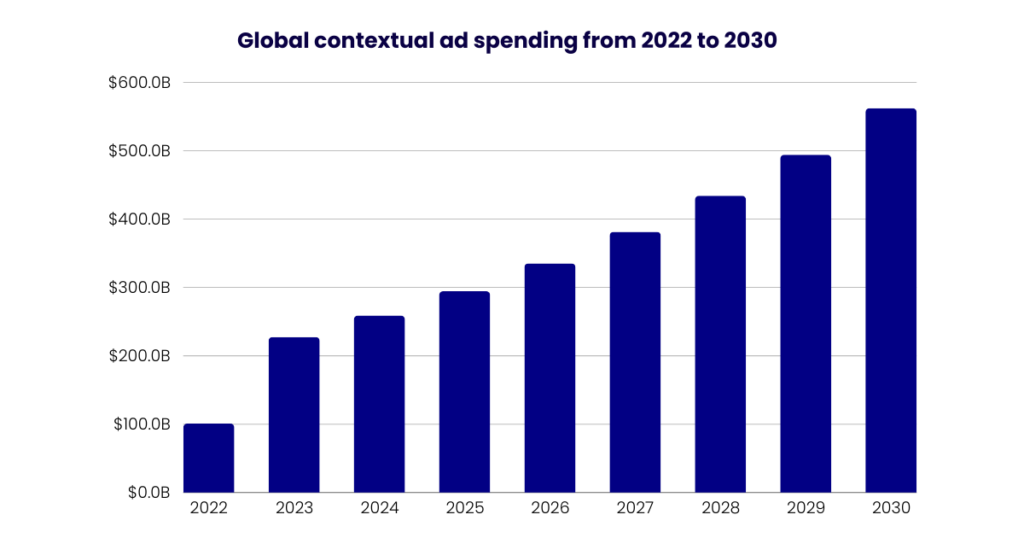Contextual advertising is nothing new. Marketers have been using this technique since the early stages of digital marketing.
But, lately, it has been experiencing a renaissance.
The reason(s)?
A growing user concern about data tracking, privacy laws, and the industry’s response to these developments. Because of all this, mobile contextual advertising will be one of the biggest mobile advertising trends in 2024.
In this article, we’ll go over everything a mobile marketer should know about mobile contextual advertising.
But first, let’s get the basics straight.
What is Contextual Advertising?
Contextual advertising is the practice of targeting ads based on the content the users are currently viewing. In this process, the algorithms match an ad to relevant content in a mobile app or a website.
How exactly does it work exactly?
Let’s put it this way.
When there’s a football game on TV, we often see male-focused commercials, such as those for beers and cars.
In a similar manner, fashion news websites often feature ads for female apparel and makeup products.
Why?
It simply makes sense.
Users who already like something related to your product are more likely to notice it than random users.
What is Mobile Contextual Advertising?
Now, let’s put this into the context of mobile app advertising.
A crypto app may target users by placing ads in finance apps, while a decoration-themed mobile game might do the same in lifestyle news apps. In the same spirit, match-3 game advertisers can place their ads in other puzzle games.
In other words, mobile contextual advertising targets users with ads that match the in-app content they’re already engaging with.
Contextual Advertising vs. Behavioral Advertising
To really understand contextual advertising, it’s important to know how it differs from behavioral advertising.
While contextual advertising is based on the audience’s environment, behavioral advertising is based on the audience’s past behavior across apps or websites.

Here’s a list of the key attributes that separate behavioral advertising from its contextual counterpart:
- Relies on tracking mechanisms to collect user data (IDFA, GAID)
- Used to target smaller user groups who have very specific interests
- Very accurate because marketers have data on the users’ interests
- Typically raises significant privacy concerns
- On iOS, it completely depends on the user’s consent (ATT opt-in)
On the other hand, mobile contextual advertising relies on different, privacy-compliant strategies:
- Relies on app metadata and other types of contextual data to display relevant ads
- Far more private than behavioral targeting
- Effective for broad targeting of larger groups of users with common interests
- Less precise because it is based on conclusions
- No need to ask users for any kind of consent
Behavioral and Contextual Advertising in Practice
Let’s say a user views an Adidas T-shirt on their phone. With behavioral targeting, marketers can track down the user and show them ads for this item everywhere — from social media apps to their favorite gaming app.
Why?
Behavioral ads are about the user, not about the place they appear in.
To be honest, people are quite fed up with ads “haunting” them wherever they go. For this reason, when asked for data tracking consent, most iOS users deny ATT opt-in (66% of them, according to Adjust).
And as you probably know, without tracking consent from the user, behavioral targeting isn’t possible.
Enters contextual targeting.
This type of targeting is all about the context in which the ad appears. In this case, the Adidas T-shirt ad would appear in relevant environments only. For example, in a fitness, sports, or clothing shopping app.
The Context of Data Privacy
Contextual advertising has been in the shadows of behavioral advertising for years. We don’t blame marketers for this — one is simply more effective than the other.
However, as advertisers started looking for data privacy workarounds, contextual advertising rose back to its former fame.
This is not only about IDFA being off the table.
By the end of 2024, Google is also going to introduce its own privacy framework, the Google Privacy Sandbox. This framework is designed to eliminate GAID (Google Advertising ID) and introduce new, privacy-compliant attribution tools.
Because of all this, advertisers know that they can’t continue to rely on behavioral advertising alone.
Instead, they are looking for ways to get the most out of the data they already have. Mobile contextual advertising uses publicly available data, which makes it completely privacy-friendly.
Contextual Advertising: Top Statistics

Are you curious about the size and scope of contextual advertising? Or about how people react to this type of marketing?
To answer this and more, we’re listing four statistics all marketers should be aware of.
- In 2023, contextual advertising spending was estimated at $227.38 billion. By 2030, it is expected to more than double, reaching $ 562.1 billion (Statista)
- 79% of people prefer seeing contextual ads over behavioral ads (GumGum)
- Mobile ads are 23% more memorable when they match the surrounding content (Integral Ad Science)
- Contextual advertising is the most popular strategy marketers use to fight the loss of third-party cookies and device identifiers. It is used by 74% of marketers, making it even more popular than first-party data at 60% (IAB)
Mobile Contextual Advertising: Targeting Possibilities
Modern mobile contextual advertising isn’t just about placing ads in obviously related environments.
Today, contextual app marketing comes with an array of targeting options, where the context is determined by many different signals. This includes the following:
- Wi-Fi data
- Ad network’s bid and price data
- Approximate location
- Device specifics (brand, version, OS, battery level, keyboard language)
- App metadata (app category, app version, etc.)
- Publisher data
You might think that, compared to behavioral data, rough location, WiFi data, or device data are useless.
But, that’s not true.
Thanks to WiFi data, you can figure out if users are at home, at work, or on the move. By knowing their rough location you can target them by weather data, local events, etc. Moreover, based on the device they use, you can assess their socioeconomic status.
Ultimately, you can use all this data to create relevant ads and deliver them to the user at the right moment.
Top 5 Benefits of Mobile Contextual Advertising
Now that you have a solid understanding of what mobile contextual advertising is, let’s sum up its main benefits. These are our top five:
- Better TTR (tap-through rates)
- Cost-effectiveness
- User privacy protection
- Fighting ad blindness (subconsciously ignoring ads)
- Fighting ad fatigue
Tips for Effective Mobile Contextual Advertising
If you would like to get started with contextual advertising, here are a couple of steps you should follow to get the best results.
1. Start Broad, Narrow Down if Possible
When launching a contextual advertising campaign, you’ll first need to pick out the topics you believe are most relevant to your target audience.
For example, on TikTok’s contextual advertising platform, TikTok Pulse, you can choose from 12 different content categories. This includes beauty, fashion, gaming, sports, health and fitness, etc.
After determining categories, some ad networks (e.g. YouTube) will allow you to narrow it down further. For example, a topic like beauty may be narrowed down to hair or makeup, while sports may be focused on football or tennis.
On some ad networks, contextual advertising isn’t based on categories, but on keywords (e.g. Google), allowing you to target even more precisely.
For this type of targeting, Google recommends using at least five and no more than 50 keywords. Equally important, you should determine negative keywords to make sure your ads don’t appear on irrelevant searches.
2. Narrow Down Further With In-App Signals
Mobile contextual targeting should never be based on wild guessing.
Not when you have all this data just waiting to be used.
As we mentioned before, contextual advertisers have different in-app signals at their disposal. But, a lot of them are not sure how they can capitalize on this. Here are some tips on how to utilize these signals when advertising across different apps:
- Focus on the app category your target audience uses most (e.g. gaming or music apps)
- For more granularity, concentrate on subcategories (e.g. mobile game genres)
- Analyze how different audiences engage with different subcategories, publishers, and their apps (e.g. Gen Z vs. Millennials)
- Focus on high-quality apps by looking into signals like rankings, downloads, and user reviews
3. Use Multiple Ad Formats
We’re sure you have some ad format preferences. But, when starting with contextual advertising, make sure you use more than one ad format.
If you don’t you might end up limiting your campaigns.
Using different types of ads in contextual advertising campaigns gives you a better chance of connecting with the right user at the right time.
Some of the most popular ad types in mobile contextual advertising are video ads, rewarded video ads, playable banners, and native ads.
4. Put Extra Effort into Ad Creatives
Once you’ve decided on the ad formats to use for your contextual campaigns, it’s time to craft ad creatives for each format.
Here, many marketers make the same mistake — they use the same ad creatives as for their behavioral marketing campaigns.
The problem with this?
Behavioral campaigns target users more precisely than contextual campaigns. In these campaigns, different types of ad creatives can perform well, even if they are completely simple (e.g. gameplay ads).
Contextual targeting is not equally precise, so it’s recommended to use particularly attention-grabbing and engaging ad creatives. To achieve this, be bold and experiment with different colors, imagery, humor, etc.
After rounds of A/B testing, you should get a clearer idea of what works and makes your brand stand out in contextual campaigns.
5. Optimize As Usual
Just like any type of advertising campaign, contextual campaigns also require optimization.
Once you launch your campaign, monitor the data, track the KPIs, and make necessary adjustments for better performance.
For instance, you may notice that your ads appear alongside irrelevant content. To resolve this issue, the majority of contextual ad networks allow you to apply content exclusions (e.g. negative keywords on Google).
Moreover, if you notice that users are seeing your ads too often, you can easily optimize this by setting a frequency cap.
Generally, it’s recommended to remove the worst-performing apps and websites and focus on several best-performing ones.
Mobile Contextual Advertising: Summing It Up
Mobile contextual advertising isn’t without its flaws.
However, it stands out as a top alternative to behavioral advertising and one of those trends that are here to stay in 2024 and beyond.
At MAF, we’re dedicated to researching and reporting about the latest mobile advertising trends and best practices. Stay informed — subscribe to our newsletter!







